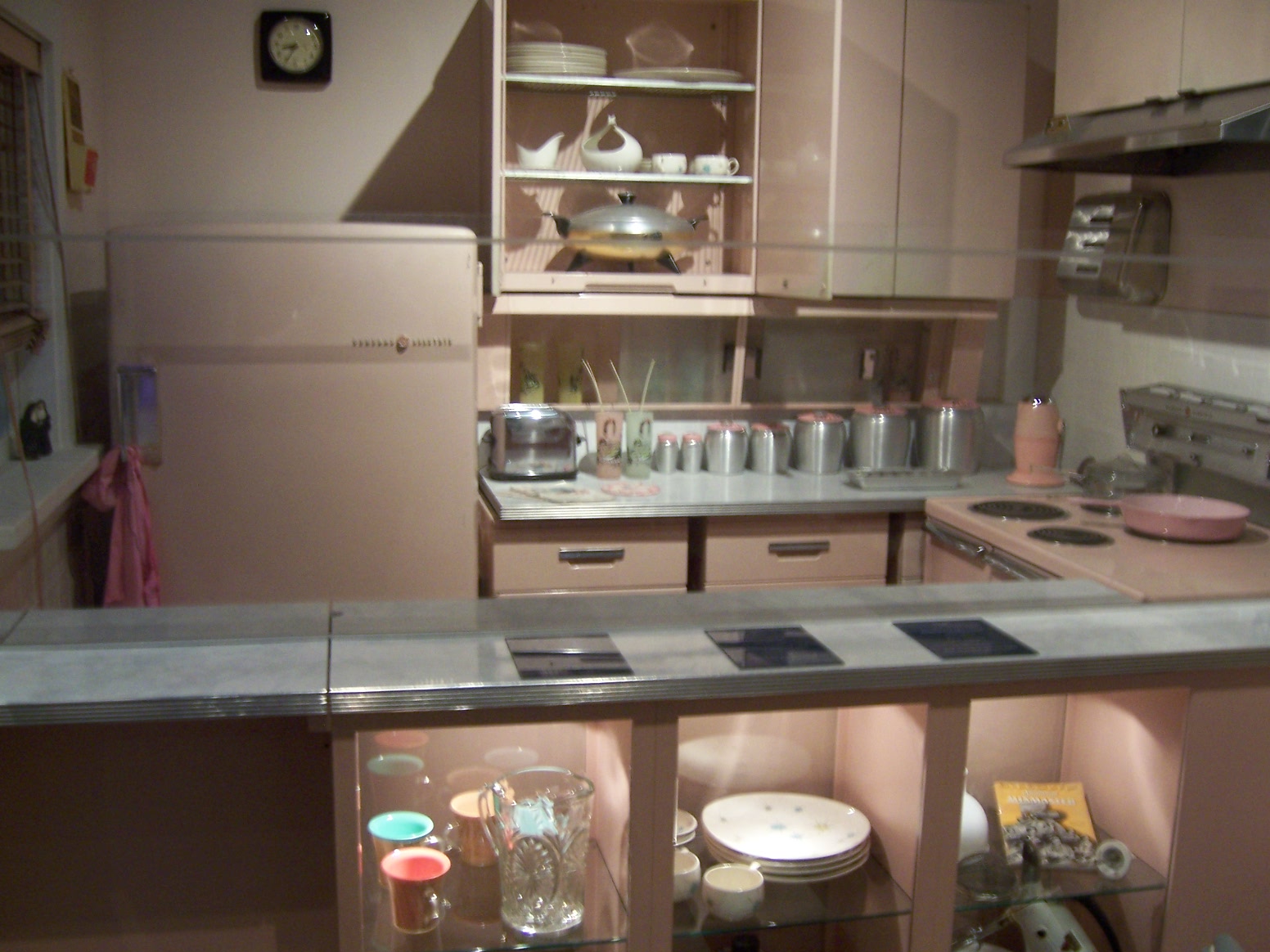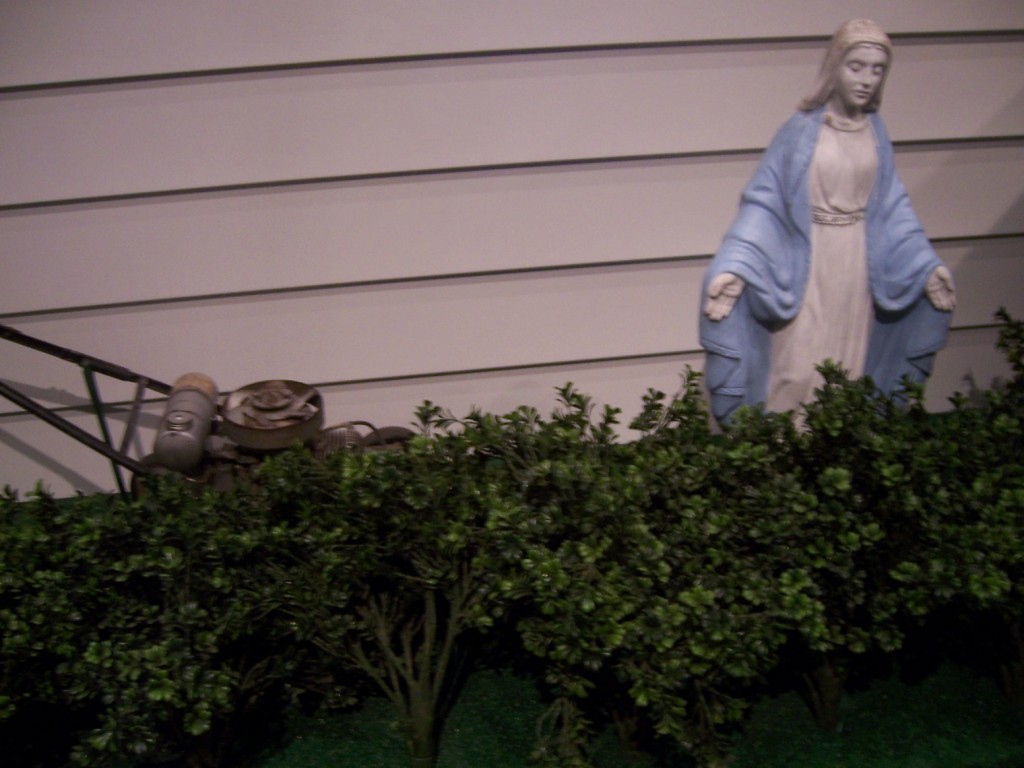This typical kitchen, circa 1950s, is part of a fascinating Missouri Historical Society exhibit on the development of St. Ann, an inner-ring St. Louis County suburb that drew many post-war families.
Originally developed in 1942 and incorporated in 1948, the community was named for the mother of the Virgin Mary. The community had a strong Roman Catholic presence, and in fact a Westridge Construction Company ad reads:
A Subdivision Dedicated to LARGE FAMILIES ONLY: MARY-RIDGE: SALE OF THESE HOMES ARE RESTRICTED TO FAMILIES OF FOUR OR MORE CHILDREN.
According to the City of St. Ann website, developer Charles F. Vatterott “started the community as a housing project for families of workers employed in nearby defense plants. It was one of the few defense housing projects in the country to develop into a permanent town.” The site goes on to say that “a lot of the family heads during this time were World War II veterans and other returning servicemen that found St. Ann was a young thriving community with moderately priced homes and attractive areas to raise their families.”
The Missouri Historical Society exhibit makes vivid and tangible the post-war move to suburbanization. In addition to the kitchen, a typical backyard is presented as well (see below).
A sign at the exhibit emphasizes that the suburbanization phenomenon was not limited to St. Ann:
Twentieth-century St. Louisans found a growing number of suburban alternatives to their older city neighborhoods. In suburbs such as St. Ann, St. Louisans lived beside neighbors with similar ideas about how they would live, shop, worship, and play.
Another exhibit sign underscores the urban sprawl that resulted:
From one subdivision to the next, from one municipality to another, twentieth-century St. Louisans shaped an increasing number of carefully planned, socially distinct communities. As the private automobile supplanted the streetcar and the truck replaced the train, metropolitan St. Louis grew ever further from its historic heart. By the end of the twentieth century, the metropolitan area was spread across 6,400 square miles in 12 counties and 2 states.
I highly recommend a visit to the Missouri Historical Society so that you can see this as well as all the other exhibits in the “Seeking St. Louis” portion of the museum. However, if you can’t get to the exhibit in person, you might want to check out this 360-degree panorama of the exhibit.
Also useful is this great YouTube video of the exhibit. Beginning at 3:39 (and running to 7:15), the video switches from an exploration of the Missouri Historical Society exhibit to footage of a 1950s-era newsreel about the advantages of moving to St. Ann. The narrator tells “The St. Ann Story”:
This story could be about you. It was Sunday, and as many of your fellow apartment dwellers did, you went driving. It was a beautiful and sunny day and the kids were all excited. The family was bundled into the car. Mom opened the door and in they went, off to a new adventure. The city we are entering is unique. As the community grew, land was set aside for all the things that make for complete community life. Schools, churches, parks, playgrounds, stores, and municipal services were added on an organized, preconceived program. Our family stops and takes the first step. They are about to discover the meaning of the great thrill in American life, the owning of your own home. So they are guided through the complicated process of buying a house. A house that is soon to become a home, filling all the needs of a young, fast-growing family. And their dream became a reality. Daily, over 26,000 cars travel over St. Charles Rock Road, the main artery in St. Ann. For the more than 14,000 who now comprise the population of St. Ann have seen for themselves the benefits they are receiving from living in a planned community. Benefits that give them the pleasure and the comfort of living in well-planned, well-constructed, well-organized homes, that are built to be homes for the average American family. Benefits that give them the joy of living in the out-of-doors, in freshness, and in beauty, clean and wholesome. Your boys and girls and my boys and girls, growing up into healthy and vital manhood and womanhood, as the citizens of tomorrow. Their children attend these modern schools. Safe, new buildings of modern design, surrounded by the large play and athletic fields. The whole family may attend one of its many fine churches. They may enjoy the three drive-in theaters, including the unique and fast, four-screen drive-in, and the ultra modern La Cosa Theater. Annual events, such as the St. Patrick’s Day Parade, are always looked forward to with great anticipation by the whole community. We welcome you to the City of St. Ann. We hope you will discover what those who already live and work here have discovered: that all the new frontiers are not gone.
Since its heyday, St. Ann has fallen on harder times, as witnessed by this contemporary footage of St. Ann.
Next week, I’ll talk about the feature most St. Louisans associate with St. Ann: Northwest Plaza.
Tags: St. Ann, Suburb, Suburbanization, White Flight

